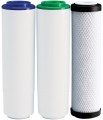The filtration rate provided by the cartridge, in other words, its maximum performance (throughput).
This indicator is directly related to the regular use of the cartridge (see above). It is also worth considering here that usually the finer the cleaning, the lower the performance of the filter element. Therefore, for example, flow pre-filter systems at the entrance to an apartment can be performant enough not to slow down the flow, but getting drinking water is inevitably associated with a slowdown in the process. This is especially true for reverse osmosis systems. Filter jugs also do not differ in performance, because they work without pressure. In addition, we note that when installing several filters in series (in a flow system), the final filtration speed will be limited by the speed of the slowest filter.
In general, when choosing a cartridge for a jug, a filter
for a tap or a travel filter, you can not pay much attention to this parameter — performance is usually guaranteed to be enough to work for its intended purpose. Detailed recommendations for other types of filters can be found in special sources.
The resource of a cartridge is the amount of water that it can effectively pass through itself and clean without loss of working qualities. For reusable models (see below), the resource between cleanings/regenerations is usually indicated.
This parameter allows you to estimate
how long the cartridge will last and how often it will need to be changed or cleaned. There are formulas that allow you to calculate the approximate water consumption depending on the number of people in the family and other factors; these formulas can be found in special sources. However, manufacturers themselves often make approximate calculations and indicate the frequency of replacement in the documents for a filter or cartridge: for example, “when used in a family of 3 people, change every month”. In fact, it is more convenient to use these recommendations.

